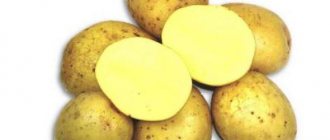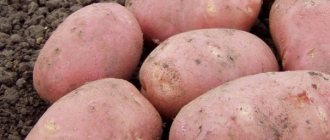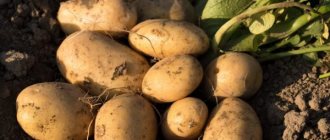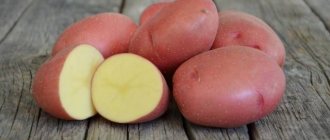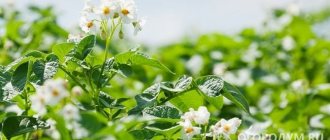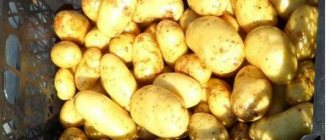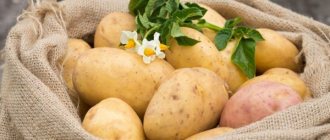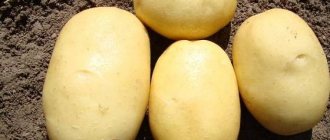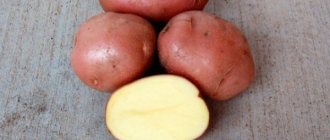Description and characteristics
| Growing season | Before the start of ripening 75 days, technical ripeness phase 80-90 days |
| Aboveground part | The stems are medium-sized and tall, straight and semi-erect. The leaves are medium and large, slightly wavy along the edges. Flowers red-violet |
| Tubers | Round-oval, few ocelli, moderately deep |
| Peel | Smooth, reddish |
| Pulp | Light yellow color, dense structure |
| Starch content | 13,0-19,9% |
| Dry matter content | 22-23% |
| Weight of marketable tubers | 100-145 g |
| Product output | 83-99% |
| Quantity in slot | 6-9 pieces |
| Productivity | 159-270 c/ha, maximum – 435 c/ha |
| Rest period during storage | 91% |
| Features of the growing season | Drought resistance |
| Disease resistance | Immune to potato cancer, scab and virus, not infected by golden nematode. Moderately susceptible to late blight of tubers - 5 points, for green mass - 3 points |
The taste of the Kurazh potato variety is rated as good and excellent. The tubers are boiled and retain a pleasant light color after heat treatment. True, not all vegetable growers agree that Kurazh potatoes are crumbly. This property of tubers depends largely on the variety, but also on the weather and fertilizing:
- Too much fertilizer increases the mass of the tuber, and starch does not have time to form;
- There is more starch in those tubers that developed primarily in dry weather.
Tubers of the Kurazh variety tolerate mechanical damage without darkening the flesh and are subject to long-distance transportation. Suitable for purees, making chips, starch.
Comment! Boiled potatoes will be crumbly if wood ash has been added.
Features of the potato variety "Courage"
Our breeders give interesting names to their offspring.
One of them, undoubtedly, attracts attention - “Courage” - given to one of the potato varieties. For almost ten years now, “Courage” has been officially recognized by Russian vegetable growers
What is behind this extraordinary name?
Description of the variety
“Courage” is a mid-early potato variety, that is, it ripens within two and a half months after germination. The bush of this plant can be of medium height, or it can be tall. Leaves are green or dark green.
Their sizes are also ambiguous: medium or large. The same can be said about the size of the flowers, which have a clearly visible red-violet color.
All these parameters directly depend on the conditions in which the potato grows: the more comfortable they are for it, the more pronounced the plant’s varietal characteristics.
The tubers of this potato are red. They are oval in shape, the skin is smooth, and the eyes on the tubers are medium in size. The pulp of “Courage” is yellowish, easily digestible, and pleasant to the taste. In addition to mashed potatoes, these potatoes make good chips.
Characteristics of the variety
This potato variety, which has proven itself well among gardeners, can be characterized in many respects as medium-stable. Judge for yourself:
- its yield ranges from 250 to 450 kg per hundred square meters;
- the tuber weighs a little over one hundred grams;
- it contains almost 20% starch;
- Having good resistance to potato cancer and golden nematode, "Courage" is sometimes vulnerable to the causative agent of late blight.
But the ability of this potato not to lose its presentation during transportation over long distances and not to deteriorate during long-term storage (subject to a certain temperature and humidity) is almost ideal.
This variety has proven itself best when grown almost everywhere in the central and regions of Russia, Moldova and Ukraine.
The “Courage” variety is known to many summer residents. They consider these potatoes to be very tasty, unpretentious, medium-yielding, but very well preserved. It is harvested in August, when other (later) varieties have not yet reached standard ripeness. This is the advantage of this variety.
Experienced gardeners give interesting advice about facilitating the labor-intensive process of planting “Courage” potatoes in the country:
- Areas with light, weed-free soil do not need to be dug up first.
- In order for the potato rows to be even, you need to draw corresponding lines on the ground before digging holes.
- It is best to fill the holes with soil from neighboring beds without turning it over. Otherwise, the top dried layer of earth will be below.
- Ash is a valuable fertilizer containing potassium, phosphorus and other substances. But, by deoxidizing and fertilizing the soil, it can also provoke the appearance of scab on potatoes. Therefore, it is better to add ash to the soil in the fall, and not before planting.
Which potato variety to choose (video)
Having become acquainted with potatoes with the rare name “Courage”, we can conclude that this variety, according to its characteristics, is quite suitable for planting in summer cottages in central Russia.
Advantages and disadvantages
| Advantages | Flaws |
| Excellent consumer qualities: smooth tubers, pleasant taste, starchiness | Shorter shelf life than other early varieties |
| Transportability | |
| Drought resistance | Rapid decrease in yield if planting material has low reproduction rate |
| Immunity to a number of dangerous cultural diseases | Susceptibility of tops to late blight |
Landing
Potatoes of the Kurazh variety are planted in April or May, when the soil to a hole depth of 8-10 cm warms up to +8°C. The tubers selected for planting weigh on average 50-70 g, small ones are used, from 25-30 g, but healthy, without damage. Starting from the middle or end of March, planting material is sorted out after storage and germinated. The temperature in the room where potato vernalization takes place is 12-15°C. The sprouts grow by 1-2 cm. Large light sprouts may break during planting. To prevent them from overgrowing, Kurazh seed potatoes should not be kept for a long time at temperatures above 16°C.
- Optimal layout of potato nests: 60-70 x 30-35 cm;
- The best predecessors are all grains and legumes, perennial and annual grasses;
- On sandy soils, it is good to plant Kurazh potatoes after lupine;
- Those areas where sunflowers were grown last year are too depleted. Potatoes are planted on them only after the autumn application of a complex of fertilizers.
Advice! Before planting, Kurazh potatoes in boxes are treated with growth stimulants and insecticides, which will help avoid the first attack of Colorado potato beetles.
How to grow
To obtain a rich and tasty harvest, complex agricultural practices are not required . It is enough to follow the standard rules for growing potatoes. Proper watering in combination with loosening, weeding and hilling ensure high-quality fruiting and keep the bushes healthy.
Pre-sowing treatment
Tuber preparation begins a month before sowing . Each potato is carefully inspected for visible damage and disease.
Spoiled seed material is disposed of. The remaining potatoes are laid out in a bright room at a temperature of +15...+17°C.
Tubers weighing no more than 100 g are selected for planting . Large root crops are subsequently cut and planted in slices. The seed material is germinated within a month, otherwise it will not sprout.
Important! Immediately before planting, the tubers are treated with a Fitosporin solution. This is a contact fungicide that protects seed material and seedlings from damage by fungal diseases.
Planting dates and scheme
Planting dates for the Courage variety are especially important . The ideal period for sowing is the first ten days of May. In the southern regions, you can focus on the end of April, but do not forget about returning frosts.
Reference. A sharp cold snap negatively affects the development of bushes. The tubers are formed smaller and differ in taste.
The soil is prepared in the fall : it is dug up with the addition of humus and wood ash. In the spring, the soil is dug up again. Before planting, a full range of mineral fertilizers is applied to the soil.
The tubers are planted to a depth of 8-10 cm. A little wood ash is placed in each hole and covered with earth.
Planting pattern : 35 cm - distance between holes, 70-75 cm - row spacing. With this planting scheme, it is convenient to care for potatoes, and the risk of diseases is reduced.
The soil temperature at the time of planting should be at least +10°C.
Further care for Courage potatoes
Crop care comes down to standard procedures that even a novice gardener can handle.
From the description of the variety it follows that it is drought resistant . But this does not mean that the plant need not be watered at all. Watering is required throughout the growing season, especially during budding and after flowering. The drier the weather, the more water is used for each bush.
In normal climates, water consumption is no more than 6 liters , and on hot, hot days it increases to 10 liters. The best indicator of watering is the top layer of soil. Do not allow it to dry out completely. The beds are kept moderately moist. In rainy weather, the amount of watering is reduced.
After watering, the wet soil is usually loosened and weeds are removed . Loosening improves air exchange, which contributes to the normal functioning of the crop. Weeds carry many diseases and serve as a favorite habitat for various insect pests, so the proximity of cultivated plants to them is undesirable. In addition, weeds take a lot of useful substances from the ground, and seedlings suffer from a lack of nutrients.
Article on the topic: Potato variety “Neptune” - description and photo
Reference . An increased level of humidity in the beds leads to the development of fungal diseases.
Hilling is carried out three times per season . It protects the tubers from direct sunlight. For the first time, the plants are earthed up as soon as they grow to 10 cm. The second procedure occurs at the time of flowering, and the third is carried out when the seedlings reach 25 cm.
In addition to the main fertilizers, foliar fertilizers are used. The first is carried out after planting when the seedlings grow poorly. Plants are fertilized with urea and ammonium nitrate. The crop also responds well to the introduction of nitrogenous substances at the initial stage.
During flowering, a second fertilizing with a predominant phosphorus content is applied. Also at this stage they fertilize with organic matter - bird droppings in a ratio of 1:10. The resulting solution is treated between the rows after abundant watering.
When the tubers ripen, the plants are fed with potassium fertilizers, thanks to which the root crops quickly gain weight and ripen.
Important! Potatoes take the main part of the nutrients for the formation of tubers from fertilizers applied during spring digging of the soil. Therefore, the land is abundantly supplied with humus and wood ash.
Diseases and pests
If you do not prevent late blight, the risk of its development increases . This fungal disease can destroy up to 70% of all plantings and easily spreads to other crops.
Protection against fungus begins with the preparation of seed, when sprouted tubers are treated with Fitosporin. During the growth of seedlings, the drugs “Ridomil” or “Avixil” are used. Preventive measures also include moderate watering, timely fertilizing and loosening the soil.
In case of disease, the affected areas of the plants are removed , and the seedlings are sprayed with Fitosporin.
Fungal spores are well preserved in weeds. This is another reason why you should clear your beds of them.
Insects that harm potatoes:
- Colorado potato beetle . It is collected by hand along with the larvae that appear on the inner surface of the leaves. When there is a large concentration of pests, the insecticide “Confidor” is used.
- Medvedka . It is difficult to notice, as it moves underground and damages the root system. Subsequently, the plant does not receive sufficient nutrition and dies. In the fight against mole crickets, the drug “Medvetox” is used, the granules of which are buried several centimeters into the ground.
- Aphid . The drug "Aktara" is used against it. It destroys pests, but is safe for humans. A sure sign of aphids appearing in the garden beds is a large number of ants. These are companions and protectors of aphids.
Daily inspection of seedlings helps to notice uninvited guests and the first signs of disease in time.
Care
The variety Kurazh is drought-resistant. The plant can develop successfully during short periods of heat, but during prolonged drought the potatoes must be watered. The plant especially needs moisture during the budding phase and after flowering. During very hot periods, the bush requires 12-20 liters of water, in normal weather - 3-6 liters. The area with Kurazh potatoes is regularly cleared of weeds and the soil is loosened, especially after watering and rain, so that a crust does not form on the surface of the soil. Air is necessary for plant roots to function normally.
Hilling and feeding
Potatoes Kurazh are hilled 2-3 times after rains or watering before flowering. The first hilling is possible even during planting, when forming a ridge that will protect the seedlings from late frosts. Usually, potatoes begin to hill when the sprouts reach 10-12 cm.
If the tops develop poorly, foliar feeding is carried out at this time. At the beginning of potato growth, the Kurazh variety is fertilized with urea, ammonium nitrate, and potassium sulfate. The second time, you can carry out foliar feeding or fertilize with mineral complexes.
Important! The main harvest of the Kurazh variety is established by fertilizing the potato plot, which is done in the fall, before plowing.
Basic landing rules
The temperature of the soil cover at the time of planting should be more than +8°C.
Temperature is measured at a depth of 10 centimeters. Before planting, absolutely all tubers are treated with a modern growth stimulator. The drug Epin is most often used because it is the most effective. When planting this potato, the height of the ridge is certainly twelve centimeters and the width is sixty-five centimeters. If the soil has a sandy composition, then all the fruits are planted to a depth of approximately ten centimeters, and if it is loamy, then to a depth of eight centimeters. During direct vegetable plantings, there is always a distance of approximately thirty-five centimeters between the bushes, and the rows are seventy centimeters wide.
You will learn more about the nuances of planting potatoes by watching the following video.
If you want to grow Courage potatoes, then you need to comply with certain conditions.
- The place for the growth of this plant is chosen where there is maximum light and no wind.
- When planting, all selected fertilizers are mixed with the soil and not thrown into holes. All this is necessary in order not to accidentally damage or spoil the planting material. Experienced gardeners do everything extremely carefully.
- Watering is carried out frequently, especially on hot days. If the air temperature is above thirty degrees, then it is advisable to water the plant both in the morning and in the evening.
- Hilling is done as soon as the bush reaches a size of twenty centimeters in height.
- The soil is loosened and thoroughly weeded.
Before planting potato tubers in the ground, the soil is fertilized with all kinds of organic and mineral modern means. Their number depends only on the composition of the soil. Quite often, gardeners add three kilograms of mineral fertilizers per hundred square meters for the entire growing period. This rule must definitely be followed.
Potatoes of the modern variety "Courage" are considered to be medium-sized varieties, and therefore they only need one high-quality fertilizing for the entire growing period. During the initial periods of development, only half of the total fertilizer is added.
To fertilize the Kurazh potatoes:
- potassium sulfate;
- urea;
- modern ammonium nitrate.
All these additives are perfectly soluble in liquid and do not contain chlorine. This element negatively affects all plants. There are also more practical complex fertilizers that contain all the substances necessary for the plant, for example, Kemira Universal. Gardeners use it quite often, speaking only positively about it.
Diseases and pests
| Diseases/pests | Signs | Treatment |
| Late blight | There are dark spots on the leaves, which are later covered with a gray coating. In cool weather, no higher than +10°C, the fungus takes over the entire area in a matter of days. Later the tubers are affected and rot | Spraying sprouted tubers with growth stimulants, which allows Kurazh potatoes to develop faster and avoid infection. Preventive treatment with fungicides. Burning the remaining stems |
| Alternaria blight | Dark dry spots on the leaves in dry weather, with a lack of moisture, spread to the stem, the plant dries out. There are rotten spots on the tubers. Productivity decreases due to the death of the green part | The disease often affects tomatoes, so potatoes are not planted nearby. Fungicide treatment. The stems are removed and burned. The disease is caused by an imbalance between insufficient nitrogen and potassium in the soil and excess phosphorus |
| Verticillium | Develops at a temperature of 17-22°C, in the flowering phase. The leaves turn yellow and curl. The plant dies. Sometimes the disease manifests itself already on the sprouts. Tubers are wilted, with lesions | Maintaining crop rotation. The stems are mowed 10 days before harvesting. Tubers are dried and sorted before storage |
| Wireworm | The larva of a click beetle that damages tubers and roots | Destroy areas of wheatgrass where the pest lives. In early spring, bait is laid out: 3 tubers per 1 square meter. m |
Harvest and storage
On the 40th day after emergence, you can begin harvesting. As a rule, this period occurs in mid-July. Remove the first greens when they grow to 10-11 cm.
It must be remembered that the plant has a bouquet type of ovary formation, therefore, the more often the fruits are picked, the faster the ovaries will ripen, increasing the yield from one bush to 10 kg, and from 1 sq. m of beds - up to 16-20 cm.
In the future, cucumbers should be removed as they ripen, preferably every 2 days. There is no need to keep them on the vines for too long, as this will negatively affect the taste of the greens and reduce the yield of the plant.
The best time to harvest is early morning or late evening. Elastic and juicy cucumbers should not be picked by hand, unscrewed or pulled by the shoots, as this can lead to the death of the plant. They need to be carefully cut with a sharp knife or sectors so that the stalk remains on the bush.
If the cucumbers collected from the bush are immediately removed to a dark and cool place (+7...+10 ºС) with a constant humidity of 80-90%, they will retain their taste and commercial qualities for 8-10 days. In this case, it is advisable to cover them with burlap or other opaque, permeable material. If you keep the fruits outside, then after 2-3 days they will become flabby and lose their attractive qualities.
Before storing cucumbers in the cellar, they need to be sorted out, removing all specimens with signs of damage, deformation or other anomalies. It is better to keep good fruits not on the floor, but on wooden pallets, in cardboard boxes or boxes. Their bottom must be lined with polyethylene in advance.
